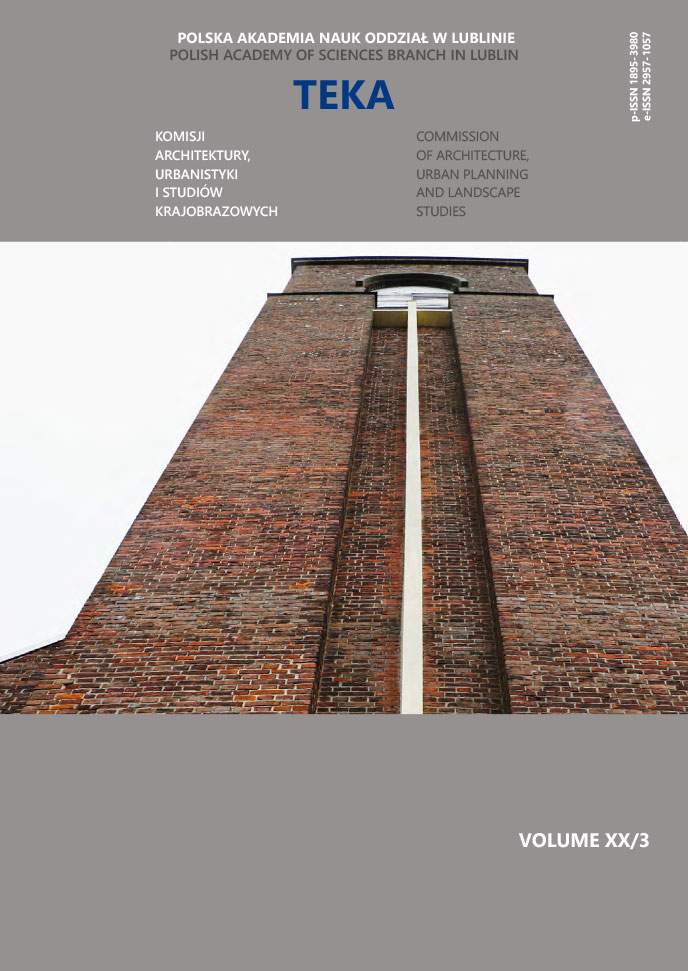Psychosomatic aspects of healthcare facility design solutions
Ewa Pruszewicz-Sipińska
Instytut Architektury, Urbanistyki i Ochrony Dziedzictwa, Wydział Architektury, Politechnika Poznańska (Polska)
Agata Anna Gawlak
Instytut Architektury, Urbanistyki i Ochrony Dziedzictwa, Wydział Architektury, Politechnika Poznańska (Polska)
Magda Matuszewska
Instytut Architektury, Urbanistyki i Ochrony Dziedzictwa, Wydział Architektury, Politechnika Poznańska (Polska)
Abstrakt
The purpose of this paper is to present the social and psychological aspects of the impact of architecture of a hospital on all its users.
The authors analyse the impact of factors shaping the architectural space of a hospital on the behaviour of patients and on the mutual relations between all the participants of the hospitalisation process.
The hospital space has been presented from the point of view of the psychophysical needs of a patient, from the point of view of the medical staff and the visitors. The analysis includes the assessment of the quality of architectural space of a hospital as a place intended for the medical treatment, which is to facilitate the recovery of the patient and fast response of the staff in emergency situations.
Bibliografia
Abrams Ch. (1971). The Language of Cities: A Glossary of Terms, 1, wg Marty Spasiewicz.
Google Scholar
Adams A., Theodore D., Goldenberg E., McLaren C., McKeever P. (2010). Kids in the atrium: Comparing architectural intentions and child’s experiences in a pediatric hospital lobby, Social Science & Medicine 70, str. 658−667.
Google Scholar
Bańka A. (1985). Psychologiczna struktura projektowa środowiska. Studium przestrzeni architektonicznej”. Poznań: Wydawnictwo Politechniki Poznańskiej.
Google Scholar
Bell P.A., Greene Th.C., Fisher J.D., Baum A. (2004). Psychologia środowiskowa. Gdańsk: Gdańskie Wydawnictwo Psychologiczne.
Google Scholar
Cherulnik P.D. (1193). Applications of Environment-Behavior Research: Case Studies and Analysis. Cambridge: Cambridge University Press.
Google Scholar
Czyński M. (2006). Architektura w przestrzeni ludzkich zachowań. Wybrane zagadnienia bezpieczeństwa w środowisku zbudowanym. Szczecin: Wydawnictwo Uczelniane Politechniki Szczecińskiej.
Google Scholar
Dalke H., Little J., Niemann E., Camgoz N., Setadman G., Hill S., Stott L. (2006). Colour and lighting in hospital design. Optics and Laser Technology 38, str. 243−365.
DOI: https://doi.org/10.1016/j.optlastec.2005.06.040
Google Scholar
Gawlak A., Matuszewska M., Szuba P., Jakość przestrzeni architektonicznej dedykowanej ochronie zdrowia a potrzeby mieszkańców w kontekście założeń idei healthy cities na przykładzie Poznania, PUA Przestrzeń Urbanistyka Architektura, 1/2018, https://doi.org/10.4467/00000000PUA.18.002.8610
DOI: https://doi.org/10.4467/00000000PUA.18.002.8610
Google Scholar
Gawlak A., Matuszewska M., Szuba P, Personnel-centred study for advancing the quality of hospital care, European Healthcare Design 2018, Sallus, Londyn 2018, http://www.salus.global/article-show/ehd2018-p08, dostęp:07.07.2018
Google Scholar
Gawlak A., Pruszewicz-Sipińska E. (2013). Architektura przestrzeni ogólnodostępnej w szpitalu. Pacjent i personel, Pielęgniarstwo Polskie 4/2013. Poznań: Wydawnictwo Naukowe Uniwersytetu Medycznego.
Google Scholar
Gehl J. (2009). Życie między budynkami. Użytkowanie przestrzeni publicznych. Cracow: Wydawnictwo RAM.
Google Scholar
Juraszyński J., Nitsch A., Porębowicz S., Radwański R. (1973). Projektowanie obiektów służby zdrowia. Warszawa: Wydawnictwo Arkady.
Google Scholar
Lenartowicz J.K. (2007). Słownik psychologii architektury. Cracow: Wydawnictwo Politechniki Krakowskiej.
Google Scholar
Meuser P. (2010). Construction and Design Manual. Medical Practices. Building Typologies Public Health. Berlin: Wydawnictwo DOM publishers.
Google Scholar
Nickl H., Nickl-Weller Ch. Hospital Architecture (2007). Wirginia: Wydawnictwo Verlagshaus Braun.
Google Scholar
Niezabitowska E. (red). (2004). Wybrane elementy facility management w architekturze. Gliwice: Wydawnictwo Politechnik Śląskiej.
Google Scholar
Pawłowska K. (red). (2010). Zanim wybuchnie konflikt. Idea i metody partycypacji społecznej w ochronie krajobrazu i kształtowaniu przestrzeni. Cracow: Foundation – Fundacja Partnerstwo dla Środowiska.
Google Scholar
Pruszewicz-Sipińska E. (red). (2015). Architecture & Health. Poznań.
Google Scholar
Spasiewicz M. (2011). Architektura i partycypacja. Czasopismo Miasto i obywatel 36.
Google Scholar
Ulrich R. S. (2008). A Review of the Research Literature on Evidence-Based. Healthcare Design, Health Environments Research & Design, 1(3).
DOI: https://doi.org/10.1177/193758670800100306
Google Scholar
Zumthor P. (2010). Myślenie architekturą, Karakter, Kraków
Google Scholar
Autorzy
Ewa Pruszewicz-SipińskaInstytut Architektury, Urbanistyki i Ochrony Dziedzictwa, Wydział Architektury, Politechnika Poznańska Polska
Autorzy
Agata Anna GawlakInstytut Architektury, Urbanistyki i Ochrony Dziedzictwa, Wydział Architektury, Politechnika Poznańska Polska
Autorzy
Magda MatuszewskaInstytut Architektury, Urbanistyki i Ochrony Dziedzictwa, Wydział Architektury, Politechnika Poznańska Polska
Statystyki
Abstract views: 194PDF downloads: 172




